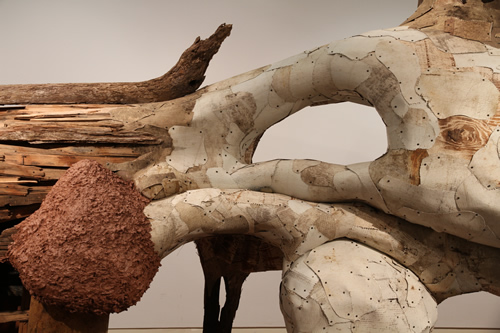Because it is probably unlike anything you’ve ever seen, it is hard to describe Henrique Oliveira‘s mammoth installation at UNC Charlotte’s Projective Eye Gallery, on view through March 12. The beastly structure, made of found materials, is a long, horizontal, floating mass of a life-like form that doesn’t allow for full comprehension.
When the artist arrived in Charlotte from Brazil, he had no pre-established plans for what his construction would look like and only began formulating ideas when he entered the room, which is in line with his modus operandi. The constraints of this space would limit his usual free reign: a long, narrow room in which he had no ability to impact the ceiling or the two completely windowed walls opposite each other. Intrigued by the way the space was viewed from the exterior of the building and, on the inside, its two separate levels, he felt the space would translate well to a container of a beast.
Oliveira spent a month collecting materials with help from his friend Chico Togni, who traveled with him from Brazil, as well as student and faculty volunteers from the school’s College of Arts + Architecture. Discarded construction materials are his bread and butter, and he truly works magic with them: wood grain becomes brushstrokes, and he seams together rusted metal, carpet padding, and fiberglass like a collagist.
The resulting form is one solid freestanding piece, so big that the perimeter narrows to the width of two people. There is no way to see the whole thing unless viewing it through one of the two glass walls; inside the gallery, it must be walked around and peered through and under. One end is bulbous and round, covered in pale green carpet padding, transitioning to grainy wood with large holes that a child could crawl into. It ends with a strong horizontal/vertical construction of narrow, squared poles reminiscent of house stilts and covered in dead vines. It sits on a series of legs and is topped by two chimney-like oil barrels, creased and crumpled like poorly cared for stove pipe hats.
In this show, Oliveira carries on his tradition of creating installations that seem to live, breathe, and grow before the viewer’s eyes, which is perhaps what appealed to Gallery Director Crista Cammaroto. His resume is filled with important institutions from cities around the world, including Paris, Rio de Janeiro, Frankfurt, Brisbane, and Sao Paulo, as well as Boulder, Houston, Cleveland, and New Orleans. He is a native of São Paolo and earned both a BFA then a Masters in Visual Poetics from São Paolo University.
After each exhibition ends, the installation is dismantled and discarded, its recycled materials going back from whence they came.
As North Carolinians, It is important that our communities continue an attitude of openness about alternative definitions of art, specifically those that consider spaces, environments, and contemporary trends. Oliveira challenges a visitor’s notions of sculpture through scale and material, and also achieves the great dream of all craftsmen: to take an uncomplicated, inanimate material and breathe another life into it. He allows the space and his own intuition to guide him, and by this is always creating freely. Without material or thematic complexity, Oliveira reminds us that beauty lies everywhere, in every object, but it is also a brief, fleeting thing.
Through 3/12. For details, see the sidebar.












